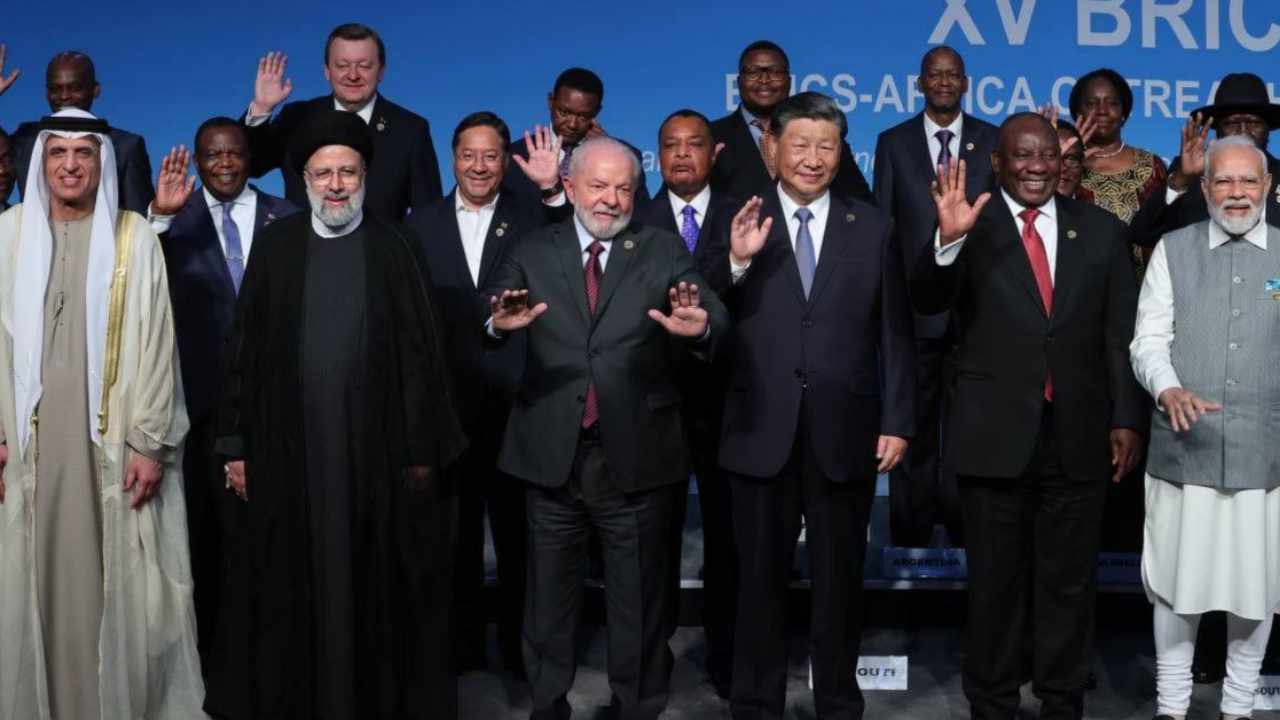
वैश्विक व्यापार में पारगमन गलियारों के विकास में ब्रिक्स प्लस की भूमिका और इसका प्रभाव
ब्रिक्स प्लस, जिसमें नए सदस्य ईरान, मिस्र, संयुक्त अरब अमीरात, सऊदी अरब और इथियोपिया शामिल हैं, अंतरराष्ट्रीय लॉजिस्टिक्स और परिवहन में एक प्रमुख खिलाड़ी के रूप में उभरा है। सुएज नहर और होर्मुज जलडमरूमध्य जैसे महत्वपूर्ण पारगमन मार्गों को नियंत्रित करके और उत्तर-दक्षिण गलियारे जैसे अंतरराष्ट्रीय गलियारों का विकास करके, ब्रिक्स प्लस वैश्विक व्यापार प्रवाह को फिर से परिभाषित कर रहा है। यह लेख समूह की पारगमन बुनियादी ढांचे के विकास में भूमिका, वैश्विक व्यापार पर इसके प्रभाव और इसके सामने आने वाली चुनौतियों की जांच करता है।

वैश्विक व्यापार में पारगमन गलियारों का महत्व
चीन की बेल्ट एंड रोड पहल या उत्तर-दक्षिण गलियारे जैसे पारगमन गलियारे वैश्विक व्यापार के लिए महत्वपूर्ण धमनियों के रूप में कार्य करते हैं। ये मार्ग महाद्वीपों के बीच माल की कुशल और लागत प्रभावी आवाजाही को सक्षम बनाते हैं। ब्रिक्स प्लस, जिसमें प्रमुख भौगोलिक क्षेत्रों में रणनीतिक रूप से स्थित सदस्य शामिल हैं, इन गलियारों को बढ़ाने की महत्वपूर्ण संभावना रखता है। उदाहरण के लिए, मिस्र का सुएज नहर पर नियंत्रण, ईरान का फारस की खाड़ी और कैस्पियन सागर तक पहुंच, और ब्राजील के प्रमुख अटलांटिक बंदरगाह वैश्विक लॉजिस्टिक्स विकास के लिए रणनीतिक लाभ प्रदान करते हैं।
पारगमन गलियारों में ईरान की भूमिका
ब्रिक्स के नए सदस्य के रूप में, ईरान पारगमन गलियारों के विकास में केंद्रीय भूमिका निभाता है। एशिया, यूरोप और मध्य पूर्व के बीच एक सेतु के रूप में इसकी भौगोलिक स्थिति पूर्व-पश्चिम और उत्तर-दक्षिण व्यापार मार्गों के एकीकरण को सुगम बनाती है। उत्तर-दक्षिण गलियारा, जो भारत से ईरान के रास्ते रूस तक फैला है, ब्रिक्स प्लस के लिए एक प्रमुख परियोजना है। यह गलियारा भारत और रूस के बीच परिवहन समय और लागत को काफी कम कर सकता है, जिससे इन देशों के बीच व्यापार को बढ़ावा मिलेगा।
इसके अतिरिक्त, ईरान द्वारा चाबहार जैसे बंदरगाहों का विकास हिंद महासागर तक पहुंच प्रदान करता है, जो भारतीय और चीनी माल के लिए मध्य पूर्व और यूरोपीय बाजारों तक पहुंचने का एक प्रवेश द्वार बनता है। ब्रिक्स के 382,000 किलोमीटर रेल नेटवर्क का हिस्सा होने वाली ईरान की विस्तारित रेल बुनियादी ढांचा समूह की परिवहन क्षमता को और बढ़ाता है।
ब्रिक्स प्लस लॉजिस्टिक्स सहयोग
ब्रिक्स प्लस वैश्विक प्रतिस्पर्धात्मकता बढ़ाने के लिए परिवहन बुनियादी ढांचे के विकास पर केंद्रित है। उदाहरण के लिए, रूस का ब्रिक्स अनाज विनिमय स्थापित करने का प्रस्ताव मूल्य स्थिरता ला सकता है और समूह के भीतर अनाज व्यापार को बढ़ावा दे सकता है। 2023 में, ब्रिक्स देशों ने 1.17 बिलियन टन अनाज का उत्पादन किया, जो वैश्विक उत्पादन का 42% था। नए सदस्यों के साथ, यह आंकड़ा बढ़कर 1.24 बिलियन टन हो गया है।
इसके अलावा, ब्रिक्स प्लस पश्चिमी-नियंत्रित मार्गों से स्वतंत्र परिवहन मार्गों का एक नेटवर्क बनाने पर काम कर रहा है। यह विशेष रूप से महत्वपूर्ण है क्योंकि पश्चिमी प्रतिबंधों ने पारंपरिक व्यापार मार्गों को बाधित किया है। उदाहरण के लिए, रूस और ईरान पर तेल प्रतिबंधों ने इन देशों को वैकल्पिक पारगमन गलियारों को विकसित करने के लिए प्रेरित किया है।
लॉजिस्टिक चुनौतियाँ
अपनी संभावनाओं के बावजूद, ब्रिक्स प्लस को लॉजिस्टिक चुनौतियों का सामना करना पड़ रहा है। कुछ सदस्य देश, जैसे इथियोपिया, अफ्रीका के हॉर्न में रणनीतिक स्थान होने के बावजूद पर्याप्त बंदरगाह बुनियादी ढांचे की कमी से जूझ रहे हैं। इसके अतिरिक्त, विशेष रूप से चीन और भारत के बीच राजनीतिक और आर्थिक तनाव लॉजिस्टिक सहयोग को बाधित कर सकते हैं। 2025 में अमेरिकी शुल्क खतरों जैसे बाहरी दबाव भी कुछ सदस्यों को पारगमन परियोजनाओं में निवेश से हतोत्साहित कर सकते हैं।
वैश्विक व्यापार पर प्रभाव
ब्रिक्स प्लस द्वारा पारगमन गलियारों का विकास वैश्विक व्यापार गतिशीलता को नया रूप दे सकता है। पनामा नहर या मलक्का जलडमरूमध्य जैसे पश्चिमी-नियंत्रित मार्गों पर निर्भरता को कम करके, ब्रिक्स प्लस व्यापार प्रवाह को वैकल्पिक मार्गों की ओर पुनर्निर्देशित कर सकता है। यह न केवल समूह के भीतर व्यापार को बढ़ावा देता है बल्कि विकासशील देशों को वैश्विक वाणिज्य में अधिक सक्रिय भूमिका निभाने के लिए सशक्त बनाता है।
इसके अलावा, पारगमन गलियारों का विकास विदेशी निवेश को आकर्षित कर सकता है। उदाहरण के लिए, ईरान के चाबहार बंदरगाह और मिस्र के सुएज नहर परियोजनाओं में चीनी निवेश इन देशों की व्यापार क्षमताओं को बढ़ा सकता है। इस तरह के निवेश रोजगार सृजन करते हैं और स्थानीय अर्थव्यवस्थाओं को मजबूत करते हैं।
निष्कर्ष
पारगमन गलियारों और लॉजिस्टिक बुनियादी ढांचे पर ध्यान केंद्रित करके, ब्रिक्स प्लस वैश्विक व्यापार में एक नेता के रूप में खुद को स्थापित कर रहा है। ईरान, मिस्र और अन्य नए सदस्यों की भूमिका इस प्रक्रिया में महत्वपूर्ण है, लेकिन सफलता आंतरिक और बाह्य चुनौतियों को पार करने पर निर्भर करती है। इस दिशा में आगे बढ़ते हुए, ब्रिक्स प्लस पश्चिमी-प्रभुत्व वाले व्यापार प्रणाली के लिए एक शक्तिशाली विकल्प के रूप में उभर सकता है।
स्रोत: एगत्साद मोआसर – विकासशील अर्थव्यवस्थाओं के हितों और अधिकारों को मजबूत करना
